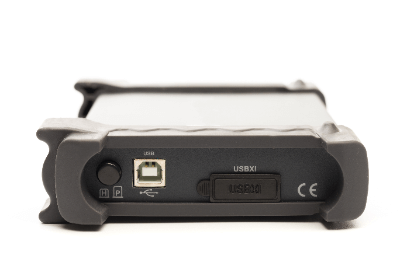What Is a USB Oscilloscope?

USB Oscilloscope is a measuring instrument that is connected to a PC via a USB interface to observe and analyze voltage waveforms.
The advantage of USB Oscilloscope is that it is smaller and less expensive than desktop oscilloscopes.
In addition, with the use of dedicated software, advanced signal processing such as frequency analysis and digital filter processing can be performed on the PC in addition to waveform observation. They are used for maintenance and inspection at factory sites and for debugging at development sites.
Uses of USB Oscilloscope
USB Oscilloscope is used to observe signals. The main applications include the following:
1. Debugging and Troubleshooting
USB Oscilloscope can be an extremely valuable tool for debugging and troubleshooting during the design and development of electronic devices. A visual representation of signals is essential when checking whether a particular signal is operating correctly or diagnosing problems in communication between devices.
2. Experiments and Practical Training in Educational Settings
In educational settings, USB Oscilloscope can help students and pupils to directly observe and understand the behavior of electronic signals. During experiments and practical training, students can relate theory to real-world observations, enhancing learning.
3. Checking Signal Quality
For electronic equipment to operate properly, signal quality must be consistent, and USB Oscilloscope enables visual confirmation of signal quality and integrity. Early detection of problems such as timing deviations, noise, and jitter is especially important in high-speed digital systems.
4. Factory Maintenance and Inspection
USB Oscilloscope is also useful for maintenance and inspection of factory equipment and systems. It monitors equipment performance and immediately warns of any abnormalities to prevent major problems before they occur.
Also, during periodic inspections, equipment performance can be evaluated and maintenance can be performed when necessary. This ensures long-term operational efficiency and reliability.
Principle of USB Oscilloscope
On the main unit side of the USB Oscilloscope, the waveform of the object under test is captured and this is converted to digital data. The role is then to transmit the data to the PC main unit via the USB terminal. Thus, the USB Oscilloscope is connected via the USB terminal of the PC.
Other Information on USB Oscilloscope
Notes on USB Oscilloscope
1. Common GND
The first point is that the USB Oscilloscope and the PC’s USB port share a common GND: If a high voltage (tens of volts or more) is inadvertently applied to the USB Oscilloscope’s GND pin, this voltage may enter the PC via the GND of the PC’s USB port.
This often destroys the PC’s USB terminal and leads to PC board failure. Therefore, inadvertent application of high voltages must be avoided.
2. Withstand voltage of USB terminals
Second, the withstand voltage of the PC’s USB terminal is not very high. Therefore, if tens of voltages are inadvertently applied to not only the GND terminal of the USB terminal but also to other terminals, the USB port of the PC or the internal circuit board may break down.
3. Operability
Third, since all settings are made using the PC keyboard, it is difficult to become accustomed to its operation. Since each keyboard is often assigned a function that is not directly related to it, it is not something that can be easily learned.
In contrast, stand-alone oscilloscopes have dedicated operation buttons, which are relatively easy to operate once you learn how to operate them.